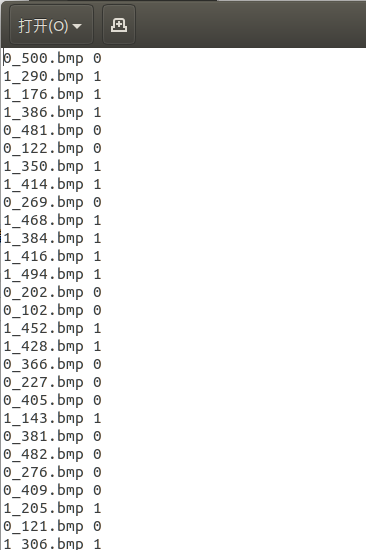docker安装caffe
docker构建容器,新建文件Dockerfile,复制进下面的内容,然后运行build构建容器,读条完毕后CPU版的docker Caffe就安装好了。
1
| docker build -t caffe:1.0 .
|
Dockerfile
1
2
3
4
5
6
7
8
9
10
11
12
13
14
15
16
17
18
19
20
21
22
23
24
25
26
27
28
29
30
31
32
33
34
35
36
37
38
39
40
41
42
43
44
45
46
47
48
| FROM ubuntu:16.04
LABEL maintainer caffe-maint@googlegroups.com
RUN apt-get update && apt-get install -y --no-install-recommends \
build-essential \
cmake \
git \
wget \
libatlas-base-dev \
libboost-all-dev \
libgflags-dev \
libgoogle-glog-dev \
libhdf5-serial-dev \
libleveldb-dev \
liblmdb-dev \
libopencv-dev \
libprotobuf-dev \
libsnappy-dev \
protobuf-compiler \
python-dev \
python-numpy \
python-pip \
python-setuptools \
python-scipy && \
rm -rf /var/lib/apt/lists/*
ENV CAFFE_ROOT=/opt/caffe
WORKDIR $CAFFE_ROOT
ENV CLONE_TAG=1.0
RUN git clone -b ${CLONE_TAG} --depth 1 https://gitee.com/mirrors/caffe.git . && \
pip install -i https://pypi.tuna.tsinghua.edu.cn/simple pip -U && \
pip config set global.index-url https://pypi.tuna.tsinghua.edu.cn/simple && \
cd python && for req in $(cat requirements.txt) pydot; do pip install $req; done && cd .. && \
mkdir build && cd build && \
cmake -DCPU_ONLY=1 .. && \
make -j"$(nproc)"
ENV PYCAFFE_ROOT $CAFFE_ROOT/python
ENV PYTHONPATH $PYCAFFE_ROOT:$PYTHONPATH
ENV PATH $CAFFE_ROOT/build/tools:$PYCAFFE_ROOT:$PATH
RUN echo "$CAFFE_ROOT/build/lib" >> /etc/ld.so.conf.d/caffe.conf && ldconfig
WORKDIR /workspace
|
样本分类和转化样本数据
运行python脚本,把样本数据装化成caffe可以识别的格式。
注意样本数据名称不能有空格如果有空格的话,需要运行下边这个脚本给样本批量重命名。
1
2
3
4
5
6
7
8
9
| @echo off&setlocal EnableDelayedExpansion
set a=1
for /f "delims=" %%i in ('dir /b *.bmp') do (
if not "%%~ni"=="%~n0" (
if !a! LSS 10 (ren "%%i" "!a!.bmp") else ren "%%i" "!a!.bmp"
set/a a+=1
)
)
|

样本分类脚本
1
2
3
4
5
6
7
8
9
10
11
12
13
14
15
16
17
18
19
20
21
22
23
24
25
26
27
28
29
30
31
32
33
34
35
36
37
38
39
40
41
42
43
44
45
46
47
48
49
50
51
52
53
|
import os
import random
image_path = '../trainImages'
txt_path = '../'
if __name__ == '__main__':
val_percent = 0.2
train_percent = 0.8
labels = os.listdir(image_path)
image_list = [os.path.join(root, fn) for root, dirs, files in os.walk(image_path) for fn in files]
image_count = len(image_list)
list = range(image_count)
tv = int(image_count * val_percent)
tr = int(image_count * train_percent)
val = random.sample(list, tv)
file_train = open(txt_path + '/train.txt', 'wt')
file_val = open(txt_path + '/val.txt', 'wt')
for i in list:
name = image_list[i]
sub_name = name[:name.rindex("\\")]
file_name = name[name.rindex("\\") + 1:]
label = sub_name[sub_name.rindex("\\") + 1:]
index = labels.index(label)
if i in val:
print('样本 (' + name + ') 标签 (' + str(index) + ') 标为验证集')
file_val.write(label + '/' + file_name + ' ' + str(index) + '\n')
else:
print('样本 (' + name + ') 标签 (' + str(index) + ') 标为训练集')
file_train.write(label + '/' + file_name + ' ' + str(index) + '\n')
file_train.close()
file_val.close()
print('完成!')
print('标签种类:')
print(labels)
print('样本总数:' + str(image_count))
print('训练集总数:' + str(tr))
print('验证集总数:' + str(tv))
exit(1)
|
生成完txt后,txt里的数据应该是这个样的。

工程结构是这个样的

开始训练
创建生成好的容器
1
| docker run -id --name caffe caffe:1.0
|
输入下边脚本进入容器,并把整个工程复制到初始的/workspace目录下。
1
| sudo docker exec -it 容器号 /bin/bash
|
1
| docker cp 本地文件的路径 container_id:<docker容器内的路径>
|
模型文件
模型都放在工程目录下的model文件夹里
solver.prototxt
1
2
3
4
5
6
7
8
9
10
11
12
13
14
| net: "/workspace/Caffe/model/train_val.prototxt" #这里时train_val.prototxt文件的路径
test_iter: 4 # x * 50 = 训练集大小
test_interval: 50
base_lr: 0.01
lr_policy: "step"
gamma: 0.1
stepsize: 100
display: 20
max_iter: 1000 #最大训练次数
momentum: 0.9
weight_decay: 0.0005
snapshot: 100 #每x次保存一次模型快照
snapshot_prefix: "/workspace/Caffe/save_model/" #生成快照的路径
solver_mode: CPU
|
train_val.prototxt
1
2
3
4
5
6
7
8
9
10
11
12
13
14
15
16
17
18
19
20
21
22
23
24
25
26
27
28
29
30
31
32
33
34
35
36
37
38
39
40
41
42
43
44
45
46
47
48
49
50
51
52
53
54
55
56
57
58
59
60
61
62
63
64
65
66
67
68
69
70
71
72
73
74
75
76
77
78
79
80
81
82
83
84
85
86
87
88
89
90
91
92
93
94
95
96
97
98
99
100
101
102
103
104
105
106
107
108
109
110
111
112
113
114
115
116
117
118
119
120
121
122
123
124
125
126
127
128
129
130
131
132
133
134
135
136
137
138
139
140
141
142
143
144
145
146
147
148
149
150
151
152
153
154
155
156
157
158
159
160
161
162
| name: "LeNet"
layer {
name: "mnist"
type: "Data"
top: "data"
top: "label"
include {
phase: TRAIN
}
transform_param {
mirror: true
crop_size: 20
mean_file: "/workspace/Caffe/train_mean.binaryproto"
}
data_param {
source: "/workspace/Caffe/train_lmdb"
batch_size: 32
backend: LMDB
}
}
layer {
name: "mnist"
type: "Data"
top: "data"
top: "label"
include {
phase: TEST
}
transform_param {
mirror: false
crop_size: 20
mean_file: "/workspace/Caffe/val_mean.binaryproto"
}
data_param {
source: "/workspace/Caffe/val_lmdb"
batch_size: 50
backend: LMDB
}
}
layer {
name: "conv1"
type: "Convolution"
bottom: "data"
top: "conv1"
param {
lr_mult: 1
}
param {
lr_mult: 2
}
convolution_param {
num_output: 20
kernel_size: 5
stride: 1
weight_filler {
type: "xavier"
}
bias_filler {
type: "constant"
}
}
}
layer {
name: "pool1"
type: "Pooling"
bottom: "conv1"
top: "pool1"
pooling_param {
pool: MAX
kernel_size: 2
stride: 2
}
}
layer {
name: "conv2"
type: "Convolution"
bottom: "pool1"
top: "conv2"
param {
lr_mult: 1
}
param {
lr_mult: 2
}
convolution_param {
num_output: 50
kernel_size: 5
stride: 1
weight_filler {
type: "xavier"
}
bias_filler {
type: "constant"
}
}
}
layer {
name: "pool2"
type: "Pooling"
bottom: "conv2"
top: "pool2"
pooling_param {
pool: MAX
kernel_size: 2
stride: 2
}
}
layer {
name: "fc1"
type: "InnerProduct"
bottom: "pool2"
top: "ip1"
param {
lr_mult: 1
}
param {
lr_mult: 2
}
inner_product_param {
num_output: 500
weight_filler {
type: "xavier"
}
bias_filler {
type: "constant"
}
}
}
layer {
name: "relu1"
type: "ReLU"
bottom: "ip1"
top: "ip1"
}
layer {
name: "ip2"
type: "InnerProduct"
bottom: "ip1"
top: "ip2"
param {
lr_mult: 1
}
param {
lr_mult: 2
}
inner_product_param {
num_output: 7 #最后输出的分类数量
weight_filler {
type: "xavier"
}
bias_filler {
type: "constant"
}
}
}
layer {
name: "loss"
type: "Softmax"
bottom: "ip2"
top: "loss"
}
|
deploy.prototxt
1
2
3
4
5
6
7
8
9
10
11
12
13
14
15
16
17
18
19
20
21
22
23
24
25
26
27
28
29
30
31
32
33
34
35
36
37
38
39
40
41
42
43
44
45
46
47
48
49
50
51
52
53
54
55
56
57
58
59
60
61
62
63
64
65
66
67
68
69
70
71
72
73
74
75
76
77
78
79
80
81
82
83
84
85
86
87
88
89
90
91
92
93
94
95
96
97
98
99
100
101
102
103
104
105
106
107
108
109
110
111
112
113
114
115
116
117
118
119
120
121
122
123
124
125
126
127
128
129
| name: "LeNet"
layer {
name: "data"
type: "Input"
top: "data"
input_param { shape: { dim: 1 dim: 3 dim: 20 dim: 20} }
}
layer {
name: "conv1"
type: "Convolution"
bottom: "data"
top: "conv1"
param {
lr_mult: 1
}
param {
lr_mult: 2
}
convolution_param {
num_output: 20
kernel_size: 5
stride: 1
weight_filler {
type: "xavier"
}
bias_filler {
type: "constant"
}
}
}
layer {
name: "pool1"
type: "Pooling"
bottom: "conv1"
top: "pool1"
pooling_param {
pool: MAX
kernel_size: 2
stride: 2
}
}
layer {
name: "conv2"
type: "Convolution"
bottom: "pool1"
top: "conv2"
param {
lr_mult: 1
}
param {
lr_mult: 2
}
convolution_param {
num_output: 50
kernel_size: 5
stride: 1
weight_filler {
type: "xavier"
}
bias_filler {
type: "constant"
}
}
}
layer {
name: "pool2"
type: "Pooling"
bottom: "conv2"
top: "pool2"
pooling_param {
pool: MAX
kernel_size: 2
stride: 2
}
}
layer {
name: "fc1"
type: "InnerProduct"
bottom: "pool2"
top: "ip1"
param {
lr_mult: 1
}
param {
lr_mult: 2
}
inner_product_param {
num_output: 500
weight_filler {
type: "xavier"
}
bias_filler {
type: "constant"
}
}
}
layer {
name: "relu1"
type: "ReLU"
bottom: "ip1"
top: "ip1"
}
layer {
name: "ip2"
type: "InnerProduct"
bottom: "ip1"
top: "ip2"
param {
lr_mult: 1
}
param {
lr_mult: 2
}
inner_product_param {
num_output: 7
weight_filler {
type: "xavier"
}
bias_filler {
type: "constant"
}
}
}
layer {
name: "loss"
type: "Softmax"
bottom: "ip2"
top: "loss"
}
|
训练脚本
1
2
3
4
5
6
7
8
9
10
11
12
13
14
15
16
17
18
19
20
21
22
23
24
25
26
27
28
29
30
31
32
33
34
35
36
37
38
39
40
41
42
43
44
45
46
47
48
49
50
51
52
53
54
55
56
57
58
59
60
61
62
63
64
65
66
| EXAMPLE=/workspace/Caffe #工程的路径
TOOLS=/opt/caffe/build/tools #caffe工具路径
TRAIN_DATA_ROOT=$EXAMPLE/trainImages/ #训练集路径
VAL_DATA_ROOT=$EXAMPLE/trainImages/ #测试集路径
RESIZE=true #这里是resize图片,我这里时开启此功能,resize成20*20
if $RESIZE; then
RESIZE_HEIGHT=20
RESIZE_WIDTH=20
else
RESIZE_HEIGHT=0
RESIZE_WIDTH=0
fi
if [ ! -d "$TRAIN_DATA_ROOT" ]; then
echo "Error: 训练集路径错误: $TRAIN_DATA_ROOT"
echo "Set the TRAIN_DATA_ROOT variable in create_imagenet.sh to the path" \
"where the ImageNet training data is stored."
exit 1
fi
if [ ! -d "$VAL_DATA_ROOT" ]; then
echo "Error: 验证集路径错误: $VAL_DATA_ROOT"
echo "Set the VAL_DATA_ROOT variable in create_imagenet.sh to the path" \
"where the ImageNet validation data is stored."
exit 1
fi
#生成前需要先删除已有的文件夹 必须,不然会报错
rm -rf $EXAMPLE/train_lmdb
rm -rf $EXAMPLE/val_lmdb
echo "删除已有的lmdb文件夹"
#训练_lmdb
echo "生成训练lmdb"
GLOG_logtostderr=1 $TOOLS/convert_imageset \
--resize_height=$RESIZE_HEIGHT \
--resize_width=$RESIZE_WIDTH \
--shuffle \
$TRAIN_DATA_ROOT \
$EXAMPLE/train.txt \
$EXAMPLE/train_lmdb
#生成的训练lmdb文件所在文件夹,注意train_lmdb是文件夹名称
#测试_lmdb
echo "生成测试lmdb"
GLOG_logtostderr=1 $TOOLS/convert_imageset \
--resize_height=$RESIZE_HEIGHT \
--resize_width=$RESIZE_WIDTH \
--shuffle \
$VAL_DATA_ROOT \
$EXAMPLE/val.txt \
$EXAMPLE/val_lmdb
#生成的测试lmdb文件所在文件夹,注意val_lmdb文件夹名称
#解锁生成的文件夹
echo "解锁lmdb文件夹"
chmod -R 777 $EXAMPLE/train_lmdb
chmod -R 777 $EXAMPLE/val_lmdb
#生成image_mean
$TOOLS/compute_image_mean $EXAMPLE/train_lmdb \
$EXAMPLE/train_mean.binaryproto
$TOOLS/compute_image_mean $EXAMPLE/val_lmdb \
$EXAMPLE/val_mean.binaryproto
#Caffe训练
mkdir -p $EXAMPLE/save_model
chmod -R 777 $EXAMPLE/save_model
caffe train --solver=$EXAMPLE/model/solver.prototxt
chmod -R 777 $EXAMPLE/save_model
echo "完成"
|
复制训练模型
训练结束后,可以使用以下命令复制出训练结束的模型到宿主机,
1
| docker cp container_id:<docker容器内的路径> <本地保存文件的路径>
|












